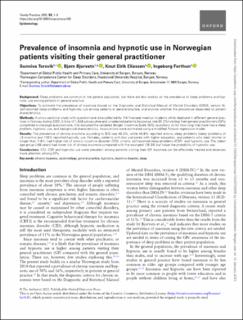| dc.description.abstract | Background
Sleep problems are common in the general population, but there are few studies on the prevalence of sleep problems and hypnotic use among patients in general practice.
Objectives
To estimate the prevalence of insomnia (based on the Diagnostic and Statistical Manual of Mental Disorders [DSM], version 5), self-reported sleep problems and hypnotic use among patients in general practice, and explore whether the prevalence depended on patient characteristics.
Methods
A cross-sectional study with questionnaire data collected by 114 final-year medical students while deployed in different general practices in Norway during 2020. A total of 1,848 consecutive and unselected patients (response rate 85.2%) visiting their general practitioners (GPs) completed a one-page questionnaire, that included the validated Bergen Insomnia Scale (BIS), questions on for how long they have had a sleep problem, hypnotic use, and background characteristics. Associations were estimated using a modified Poisson regression model.
Results
The prevalence of chronic insomnia according to BIS was 48.3%, while 46.9% reported chronic sleep problems (sleep problems of ≥3 months) and 17.8% reported hypnotic use. Females, patients with low compared with higher education, and patients who slept shorter or longer than 7–8 h, had higher risk of chronic insomnia disorder (CID), chronic self-reported sleep problems (CSP), and hypnotic use. The oldest age group (≥65 years) had lower risk of chronic insomnia compared with the youngest (18–34) but twice the probability of hypnotic use.
Conclusions
CID, CSP, and hypnotic use were prevalent among patients visiting their GP. Insomnia can be effectively treated and deserves more attention among GPs. | en_US |

